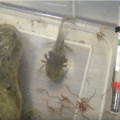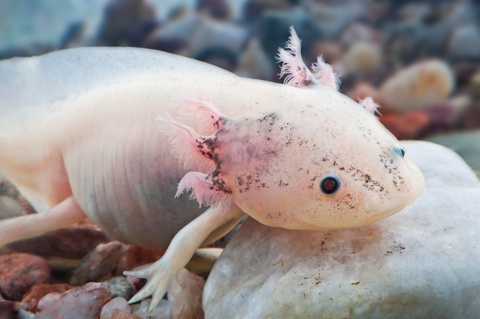Table of Contents
Who would have thought that hardy animals can be as cute as an axolotl? These creatures are tame in nature and something that should be thought of as a display pet since they cannot interact with their pet owners outside of their tank. One must keep in mind that they are delicate and soft – bodied amphibians with permeable skin which implies that Axolotls should not be handled unless absolutely necessary. They are not social animals and do not benefit from having a companion so don’t you dare put a fish in their aquarium!
Keeping Cute Axolotls
- Axolotls can get quite large for a salamander which is why you need to provide them at least a fifteen to twenty gallon. The tank doesn’t have to be full of water because it should only be a bit deeper than the full length of the animal.
- Make sure that the tank is kept in a cool room away from bright sunlight. No special lighting is required for axolotls compared to reptiles.
- Make sure that the gravel you used on the bottom of the tank is coarse gravel. Fine gravel might be ingested during feeding and could cause an obstruction which can lead to digestive problems. Some owners opt to simply leave the bottom of the tank bare, although others believe this may stress the axolotls a bit since they can’t get a foothold on the bottom of the tank without gravel.
- If you’re keeping a Juvenile axolotl, keep in mind that they have a cannibalistic attitude if you put in another axolotl in the same aquarium, so they are best raised in separate enclosures. Adults can potentially be housed together but watch for cannibalistic tendencies.
- Most owners will find a filtered aquarium easier to maintain than one without a filter since unfiltered water will need frequent changing. Make sure that if you have a filter on the tank, the filtration rate should be fairly slow. Powerful filters that create strong currents should be avoided.
- If you have a filter, safe cleaning would consist of using a siphon to vacuum the bottom of the tank, and a 20% water change must be done every week. If you are not using a filter, you will have to do a 20% water change every day or every other day. Don’t do a full water change as this can start a situation where the water chemistry changes too drastically that will make your pet uncomfortable.
- Tap water should have any chlorine or chloramines removed using commercially available solutions. Don’t use distilled water and make sure the pH of the water remains between 6.5 and 7.5
Characteristics of Axolotls
Cute Axolotls are available in colors like grey, white albino, golden albino, and other varieties like shades of brown. The normally colored axolotl appear as a near – black color though some have chocolate brown shade, and also appear as a creamy color or anywhere in between. There are also so – called piebald axolotls that come in various colors.
A variety that is piebald is known as the harlequin and it comes in more than one color. There have been efforts to multiply and breed the Axolotl and release it in order to establish again its population. However, the location of the remaining waterways where the Axolotl species once lived or may live are most likely to be threatened due to the city’s continuous expansion, and the days of the cute Axolotl surviving in the wild are only quite limited.
The Axolotl is an iconic creature and it is also Mexico’s national symbol and because it breeds quite easily in an aquarium, it is a beloved pet around the world. There are a lot of axolotls that live in captivity. There are also lots of axolotls every year that are being used in scientific research and it’s usually because researchers just can’t get enough of their miraculous regeneration abilities thus axolotls are studied in laboratories all over the world. The Xochimilco canals located in Mexico City is the only remaining habitat of the axolotls but due to pollution the axolotl has become a rare sight.
In mammals including us humans scars build up rapidly which prevent tissue regeneration unlike in cute Axolotl which can repair deep tissue wounds without any scarring. This is because of the so – called blastema which is a group of cells that cover the amputation wound.
While macrophages a type of immune cell that gobbles up dead cell are responsible for scarring mammal species, scientists found that in the axolotl, these macrophages are what contribute to the amazing regeneration and wound – healing process. In fact, macrophages are also the reason why axolotl creatures can regenerate a cut – off or broken heart.
Scientists deciphered how molecules arrange the limb regeneration of axolotls, though there are lots of open questions that remain to be unanswered. Regeneration biologists aren’t limiting themselves to the axolotl as they have focused on trying to understand why mammals cannot regenerate or doesn’t have the same capabilities. Adult mice and humans can regenerate fingertips but this is an ability that they lose with age though it gives hope to scientists and researchers who are trying to figure out how to reawaken our regenerative abilities.
Purchasing and Owning an Axolotl
Before you purchase a cute axolotl, you should talk to a representative from your state’s agency. Axolotls are legal in most places in the U.S. except for California, Maine, New Jersey, and Virginia. In New Mexico, they are legal to own but illegal to import from other states. So, depending on your state, you may be able to acquire an axolotl from a breeder or an exotic pet dealer. Make sure to not buy these animals through the internet or any other kind of black – market or illegal pet trading schemes. We highly recommend that you speak to an exotics veterinarian if you are looking for a reputable source.






 Author and long-time animal lover. Sharing knowledge on pet care through experience and the written word.
Author and long-time animal lover. Sharing knowledge on pet care through experience and the written word.